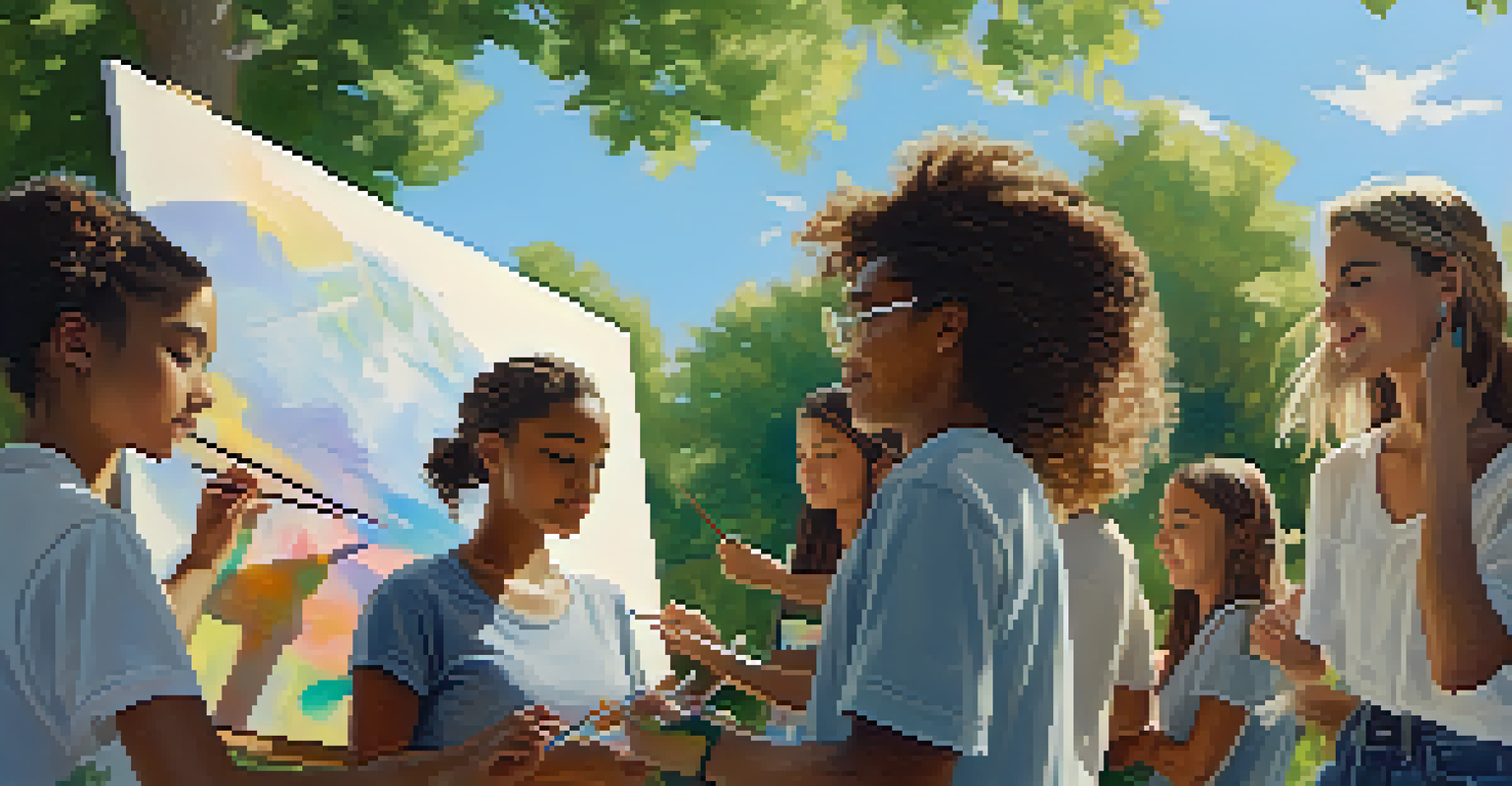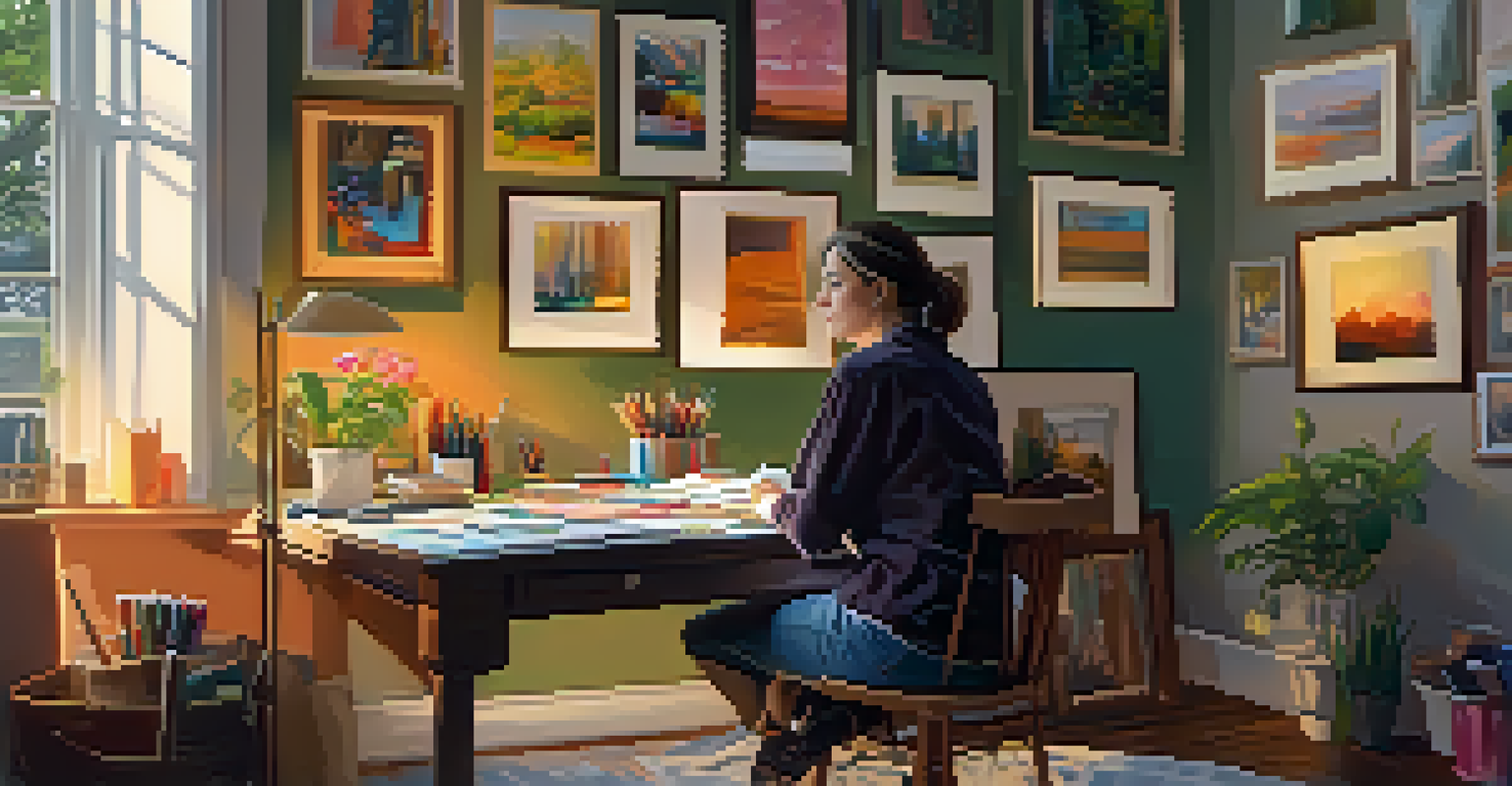Mindfulness in Arts Education: Unlocking Creative Potential

Understanding Mindfulness in Arts Education
Mindfulness is the practice of being present and fully engaged in the moment. In arts education, it means encouraging students to focus on their creative process without distractions. This approach not only enhances their artistic skills but also fosters emotional resilience and self-awareness.
Mindfulness isn’t difficult. What’s difficult is to remember to be mindful.
When students practice mindfulness, they become more attuned to their thoughts and feelings, allowing them to express themselves authentically through their art. This connection between awareness and creativity is essential, as it helps learners tap into their inner resources. Ultimately, mindfulness becomes a powerful tool for unlocking their creative potential.
Incorporating mindfulness into arts education can take many forms, such as meditation, breathing exercises, or simply encouraging quiet reflection before creating. By creating a calm and focused environment, educators can help students feel more comfortable exploring their artistic expressions.
The Benefits of Mindfulness for Young Artists
Mindfulness offers numerous benefits for young artists, including improved focus, reduced anxiety, and enhanced creativity. When students can concentrate on their tasks without the noise of external distractions, they can dive deeper into their creative processes. This heightened focus can lead to more innovative ideas and unique artistic expressions.

Additionally, many students experience anxiety when it comes to creating art, fearing judgment or perfectionism. Mindfulness practices can help alleviate these feelings by encouraging self-compassion and acceptance of imperfection. By promoting a positive mindset, students are more likely to take risks and explore new techniques.
Mindfulness Enhances Creativity
Practicing mindfulness in arts education helps students focus and express themselves authentically, unlocking their creative potential.
Ultimately, the integration of mindfulness into arts education can lead to a more fulfilling and enjoyable creative experience. Students learn to appreciate their artistic journey rather than solely focusing on the final product, which can enhance their love for the arts.
Practical Mindfulness Techniques for the Classroom
Many practical mindfulness techniques can be easily integrated into arts education. Simple breathing exercises can help students center themselves before starting a project, clearing their minds of distractions. This practice can create a sense of calm, allowing for a more productive creative session.
Creativity is intelligence having fun.
Another effective technique is guided imagery, where educators encourage students to visualize their ideas before putting them on paper or canvas. This method not only sparks creativity but also helps students develop a clearer vision of their artistic goals. By fostering a mental picture, they can tackle their creative endeavors with confidence.
Finally, incorporating regular moments of reflection can significantly enhance the mindfulness experience. After completing an artwork, students can take time to contemplate their process, emotions, and what they learned. This practice deepens their understanding of their creative journey and cultivates a more thoughtful approach to their art.
Mindfulness and Collaboration in Arts Education
Collaboration is a vital aspect of arts education, and mindfulness can enhance this experience. When students practice mindfulness together, they learn to listen actively and engage with each other's ideas. This shared awareness fosters a supportive environment where creativity can flourish.
Moreover, mindfulness encourages empathy, enabling students to connect with their peers on a deeper level. By understanding their classmates’ perspectives and feelings, students can create more meaningful collaborative projects. This sense of community not only enriches their artistic experience but also builds lasting relationships.
Benefits for Emotional Resilience
Incorporating mindfulness cultivates self-awareness and emotional resilience, enabling students to manage anxiety and embrace imperfection.
Creating group mindfulness activities, such as collective breathing exercises or group discussions about art, can strengthen these collaborative skills. As students become more attuned to one another, they’re likely to produce more cohesive and innovative works of art together.
Overcoming Challenges with Mindfulness in Arts Education
Implementing mindfulness in arts education can come with its own set of challenges. One common issue is the resistance from students who may feel skeptical about mindfulness practices or view them as a waste of time. Educators must approach this hesitance with patience and provide relatable explanations of the benefits.
Another challenge is finding the right balance between mindfulness practices and the creative process. While mindfulness is essential, students still need room to experiment and express themselves freely. Teachers should strive to integrate mindful moments seamlessly into their lessons without stifling creativity.
Finally, ensuring that all students feel included in mindfulness practices is crucial. Educators should be sensitive to diverse backgrounds and experiences, adapting techniques to meet the needs of each student. By doing so, they create an inclusive environment where everyone can benefit from mindfulness.
Mindfulness as a Lifelong Skill for Artists
The benefits of mindfulness extend far beyond the classroom, equipping young artists with lifelong skills. By practicing mindfulness in arts education, students develop habits that can improve their overall well-being and resilience in the face of challenges. This skill set can serve them well, regardless of their future artistic endeavors.
As they grow, these individuals may face various stressors in both their personal and professional lives. Having a mindfulness practice allows them to navigate these pressures with greater ease, helping them maintain their creativity and passion for the arts. The tools learned in the classroom can become invaluable coping mechanisms.
Collaboration Through Mindfulness
Mindfulness fosters empathy and active listening among students, enhancing collaboration and deepening their artistic relationships.
Ultimately, embracing mindfulness in arts education not only nurtures creativity but also instills a sense of balance and self-awareness. This holistic approach prepares young artists to thrive in all aspects of their lives, fostering a generation that values both creativity and mindfulness.
Future Perspectives on Mindfulness in Arts Education
As the importance of mental health and creativity gains recognition, the integration of mindfulness in arts education is likely to expand. Schools and educators are increasingly realizing the value of fostering emotional intelligence alongside artistic skills. This shift signifies a promising future for students in arts programs.
Innovative teaching methods, such as virtual mindfulness sessions and community workshops, are emerging to support this trend. These initiatives aim to make mindfulness practices more accessible to a wider audience, ultimately benefiting students from diverse backgrounds. The potential for growth in this area is vast and exciting.

Looking ahead, the integration of mindfulness into arts education may become a standard practice, enriching the curriculum and the overall educational experience. By prioritizing both creativity and emotional well-being, we can create a nurturing environment where young artists can truly thrive.